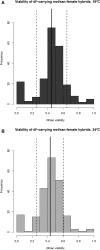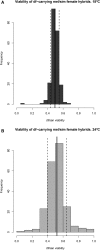The Effect of Temperature on Drosophila Hybrid Fitness
- PMID: 27913636
- PMCID: PMC5295587
- DOI: 10.1534/g3.116.034926
The Effect of Temperature on Drosophila Hybrid Fitness
Abstract
Mechanisms of reproductive isolation inhibit gene flow between species and can be broadly sorted into two categories: prezygotic and postzygotic. While comparative studies suggest that prezygotic barriers tend to evolve first, postzygotic barriers are crucial for maintaining species boundaries and impeding gene flow that might otherwise cause incipient species to merge. Most, but not all, postzygotic barriers result from genetic incompatibilities between two or more loci from different species, and occur due to divergent evolution in allopatry. Hybrid defects result from improper allelic interactions between these loci. While some postzygotic barriers are environmentally-independent, the magnitude of others has been shown to vary in penetrance depending on environmental factors. We crossed Drosophila melanogaster mutants to two other species, D. simulans and D. santomea, and collected fitness data of the hybrids at two different temperatures. Our goal was to examine the effect of temperature on recessive incompatibility alleles in their genomes. We found that temperature has a stronger effect on the penetrance of recessive incompatibility alleles in the D. simulans genome than on those in the D. santomea genome. These results suggest that the penetrance of hybrid incompatibilities can be strongly affected by environmental context, and that the magnitude of such gene-by-environment interactions can be contingent on the genotype of the hybrid.
Keywords: Drosophila; hybrids; postzygotic isolation; temperature.
Copyright © 2017 Miller and Matute.
Figures





Similar articles
-
Incompatibility between X chromosome factor and pericentric heterochromatic region causes lethality in hybrids between Drosophila melanogaster and its sibling species.Genetics. 2012 Jun;191(2):549-59. doi: 10.1534/genetics.112.139683. Epub 2012 Mar 23. Genetics. 2012. PMID: 22446316 Free PMC article.
-
Fine mapping of dominant X-linked incompatibility alleles in Drosophila hybrids.PLoS Genet. 2014 Apr 17;10(4):e1004270. doi: 10.1371/journal.pgen.1004270. eCollection 2014 Apr. PLoS Genet. 2014. PMID: 24743238 Free PMC article.
-
Abundant genetic variability in Drosophila simulans for hybrid female lethality in interspecific crosses to Drosophila melanogaster.Genet Res (Camb). 2012 Feb;94(1):1-7. doi: 10.1017/S0016672312000031. Genet Res (Camb). 2012. PMID: 22353244
-
Evolutionary dynamics of pre- and postzygotic reproductive isolation in cichlid fishes.Philos Trans R Soc Lond B Biol Sci. 2020 Aug 31;375(1806):20190535. doi: 10.1098/rstb.2019.0535. Epub 2020 Jul 13. Philos Trans R Soc Lond B Biol Sci. 2020. PMID: 32654645 Free PMC article. Review.
-
Maladaptive learning and memory in hybrids as a reproductive isolating barrier.Proc Biol Sci. 2018 May 30;285(1879):20180542. doi: 10.1098/rspb.2018.0542. Proc Biol Sci. 2018. PMID: 29848649 Free PMC article. Review.
Cited by
-
Increased proteomic complexity in Drosophila hybrids during development.Sci Adv. 2018 Feb 7;4(2):eaao3424. doi: 10.1126/sciadv.aao3424. eCollection 2018 Feb. Sci Adv. 2018. PMID: 29441361 Free PMC article.
-
The importance of intrinsic postzygotic barriers throughout the speciation process.Philos Trans R Soc Lond B Biol Sci. 2020 Aug 31;375(1806):20190533. doi: 10.1098/rstb.2019.0533. Epub 2020 Jul 13. Philos Trans R Soc Lond B Biol Sci. 2020. PMID: 32654642 Free PMC article. Review.
-
Temperature affects conspecific and heterospecific mating rates in Drosophila.bioRxiv [Preprint]. 2024 Oct 28:2024.10.28.620639. doi: 10.1101/2024.10.28.620639. bioRxiv. 2024. PMID: 39553966 Free PMC article. Preprint.
-
Gene regulation and speciation in a migratory divide between songbirds.Nat Commun. 2024 Jan 2;15(1):98. doi: 10.1038/s41467-023-44352-2. Nat Commun. 2024. PMID: 38167733 Free PMC article.
-
The paradox behind the pattern of rapid adaptive radiation: how can the speciation process sustain itself through an early burst?Annu Rev Ecol Evol Syst. 2019 Nov;50(1):569-593. doi: 10.1146/annurev-ecolsys-110617-062443. Epub 2019 Oct 1. Annu Rev Ecol Evol Syst. 2019. PMID: 36237480 Free PMC article.
References
-
- Austin C. J., Moehring A. J., 2013. Optimal temperature range of a plastic species, Drosophila simulans. J. Anim. Ecol. 82: 663–672. - PubMed
-
- Bordenstein S. R., Drapeau M. D., 2001. Genotype-by-environment interaction and the Dobzhansky–Muller model of postzygotic isolation. J. Evol. Biol. 14(3): 490–501.
-
- Bordenstein S. R., O’Hara P. F., Werren J. H., 2001. Wolbachia-induced incompatibility precedes other hybrid incompatibilities in Nasonia. Nature 409: 707–710. - PubMed
MeSH terms
LinkOut - more resources
Full Text Sources
Other Literature Sources
Molecular Biology Databases
